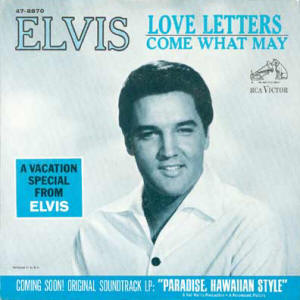Verdict
With an uptempo song and a ballad this single offers variety. No matter if one regards "Come What May" or "Love Letters" to be the a-side, it's a strong release anyway.
![]()
(C) RCA Victor
The ultimate site about the king of the analogue age


The latest Presley single was shipped on June 8, 1966 and featured the songs "Come What May" and "Love Letters". In contrast to RCA Victor the Billboard Magazine regarded "Love Letters" to be the main song and listed it on July 2nd at number 57 of the "Hot 100". Within its stay of seven weeks it peaked at number 19. Outside the US "Love Letters" was also considered to be the a-side and made it into the top 30s of many countries. In Great Britain the track even peaked at number 5. During its initial sales period RCA Victor retailed 450,000 copies, the total global volume of sales is 1.25 million units. According to the RIAA this figure translates to 187.5 million paid streams. Therefore the sales even undershot the ones of the previous single and Elvis once again was unable to come up with a hit.
On the streaming platforms this single cannot be found. But "Come What May" was added to the digital version of the CAMDEN release "I Got Lucky" (1971) and "Love Letters" is a part of the original RCA longplayer "Elvis' Gold Records - Volume 4" (1968). In 2016 the complete Presley catalogue was restored and remastered by Vic Anesini for a boxed set of 60 compact discs called "The Album Collection". Sony Music Entertainment provides the streaming platforms with the same versions of the individual tracks, albeit in 24 bit/90 khz flac. That means, if the platform of your choice supports high resolution audio, you can enjoy the songs in the same quality Sony used to scan and master them. On Spotify, which has a market share of approximately 30% and is the only platform that publishes streaming figures, "Love Letters" accumulates 10 million streams, half of them can be allocated to the remake, which features The Royal Philharmonic Orchestra. "Come What May", the supposed a-side, hasn't even passed the million mark.
For me the cover of this single belongs to the most appealing onces. RCA Victor designed the sleeve with a promo shot for Elvis' upcoming movie "Paradise, Hawaiian Style". Of course the label didn't forget to advertise the accordant soundtrack album, which was about to hit the stores soon. Why the single, which contained two brand new recordings, was promoted as "vacation special" remains a mystery.
Come What May
The singer swears to be faithful to his loved one - come what may. The original version was recorded by Al Casey in 1957, but without doubt Elvis favored Clyde McPhatter's cover. The king recorded "Come What May" on May 28, 1966 at RCA Studio B in Nashville/Tennessee within eight takes. Elvis and the band are loose as a goose and deliver a very casual, almost boisterous performance. I like it very much, because it's obvious that everybody had fun in the studio. By the way: "Come What May" was written by Franklin Tableporter.
Love LettersThe ballad was written by Victor Young and is the titel song of the movie "Love Letters", released in 1945. Young recorded an instrumental version with his orchestra in January of that year, later Edward Heyman added lyrics. Dick Brown was the first to record it that way, later he was followed by many other stars. Perry Como and Elvis Presley even recorded "Love Letters" twice. Como in 1945 and 1958, Presley in 1966 and 1970. In 1976/77 Elvis also performed the song live on stage. The recording on this single was made on May 26, 1966 at RCA Studio B in Nashville/Tennessee. The king needed nine takes to get the song right. "Love Letters" is a strong ballad and Elvis performs it extremely well. Neither his re-recording, nor any of his live performances match the beauty of his original version. In 1968 the track was included on "Elvis' Gold Records - Volume 4".
With an uptempo song and a ballad this single offers variety. No matter if one regards "Come What May" or "Love Letters" to be the a-side, it's a strong release anyway.
![]()
(C) RCA Victor